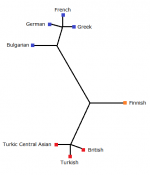Hi Bicicleur

I've read these are some of the oldest skeletons found in Europe - dated 43,000 B.C. They were found in
the caverns of Grimaldi (Baousse-Rousse), somewhere between Mentone and Ventimiglia (on the Italian side). They are some of most paleolithic caverns in Europe. They are apparently complete. Genetically speaking, they are modern humans.
Some theorists argue they are Khosian people that "walked" into Europe via the Gibraltar Straits,
circa 45,000 B.C when the Great Glacial Ice Sheets of Europe started to melt. It seems they traversed
all of Europe, Northern Asia and Mal'ta in Siberia/ Russia, north of Mongolia. They did not become extinct, as they are modern humans.
They also seems to be responsible for the Gravettian and Aurignacian artifacts.
Thus, I think if you want to get really accurate, the first Europeans were actually African, and most probably Khoisan. Also, the dating of modern humans are theorised by some researchers to be even earlier thus older than what is conventionally dated for Cro-Magnon/ Neanderthal "hybrid" humans.
Cheers !
Thanks for your comment Aberdeen!
As far as I'm aware,
The Odyssey was written/ recorded well after its oral tradition commenced. It also features themes that resemble the ancient Gilgamesh epic. Consequently, some theorists have suggested
The Odyssey, as an oral tradition, could actually be more ancient than the believed 1200- 800 B.C. dating. In this way, perhaps new elements were added to the oral version of
The Odyssey which reflect a later epoch i.e. the setting of the Trojan War.
Also, the theorist Lord, in "Homer as Oral Poet", conjectured a close cultural/ literary relationship between the Homeric and Balkan oral traditions/ poems. So, it seems there is evidence of a cultural diffusion of sorts between ancient Hellenic Greece and Illyria/ the West Balkans, perhaps even a single historical cultural reservoir. But is this so surprising? They are neighbours after all...
Furthermore, if you look at the haplogroup profile of modern Greece, while more diverse than the West Balkans, it has some surprisingly similar features to the West Balkans; namely a haplogroup I presence as well as a significant haplogroup J and haplogroup Ra presence.
Furthermore, to better illustrate the comparatively close Illyrian/ Germanic/ Hellenic cultural (even genetic) ancestry, there is a diagram in Wikipedia under "Genetic History of the Turkish People" which shows comparative haplogroup profile affinities of several European nations.
You will notice that Greece and Germany [even France] are comparatively closer in haplogroup composition than England and Turkey. Thus, if "Germanic" countries, particularly Scandinavian countries, have high concentrations of haplogroup I - just as West Balkan countries, it would then follow that Illyria/ West Balkans/ "Germanic"-Scandinavian/ ancient Hellenic Greece, share a (notable) degree of cultural/ genetic heritage. Thus, citing the evidence above, there seems to me significant support for theorising a combined Illyrian/ ancient Hellenic/proto-Germanic (proto-Celtic) culture, e
ven ancestry.
As for the Irish sagas, perhaps these reflect Ireland's "indigenous" haplogroup I oral traditions (i.e. proto-Germanic/ proto-Viking?)/proto-Celtic/ Illyrian oral tradition) recorded at a later date?
Cheers



